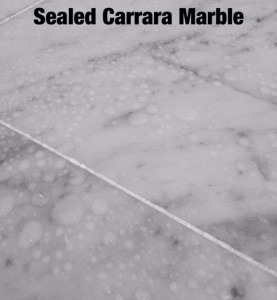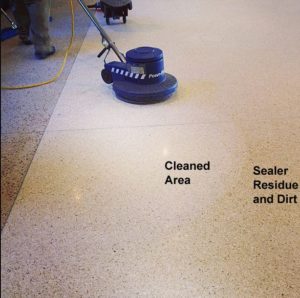First off, what is sealer residue?
Let me elaborate: It is a common misconception to think that all stone sealers are surface coatings. Yes, there are certain sealers that are meant to coat the surface; however, we typically recommend a penetrating (or impregnator) sealer for natural stone. Penetrating sealers/impregnators are either water-based or solvent-based.

Penetrating or Impregnator sealers work a little differently compared to surface forming sealers/coating: you apply the penetrating sealer to the stone and grout surface, let stand for 15-20 minutes, then wipe off the remaining sealer that did not soak into the pores of the stone and grout.
Sealer residue means the penetrating sealer has been misapplied and has left a cloudy/hazy look to the natural stone surface. Sealer residue can sometimes feel a little greasy or sticky to the touch.
In other words, sealer residue is the remaining sealer that was not wiped off properly after that 20 minutes. Here are some simple tips to avoid sealer residue:
- Don’t treat a penetrating sealer like you would treat a surface coating sealer. By this statement I mean: don’t apply the penetrating sealer and leave it to dry.
- Do not wait longer than 20 minutes to wipe off the excess sealer that did not soak into the stone and grout. If you wait too long, the sealer dries into a residue.
- After that 20 minutes, be very thorough when you wipe off the excess sealer, use a very absorbent cotton cloth or similar material. Make sure you wiped all of the sealer off.
Ok, so what happens if you do have sealer residue?
If you used a solvent-based penetrating sealer, good news: the solvent in the sealer removes the solvent residue that is left on the stone surface.
If you want to remove solvent-based sealer residue from a stone countertop, simply spray more of that same sealer on a cotton cloth and wipe down your countertops as if you are cleaning them.
If you have sealer residue on the floor, spray more of that same sealer on the floor and buff with a white pad (in sections – you can’t tackle the whole floor at one time).
Now, if the penetrating sealer was a water-based sealer, you need to use a stripping product such as Green Solution Floor Finish Remover. Water-based sealer residues cannot simply be cleaned off; they need to be stripped.
Please keep in mind that sealer residue is an issue that is easily solved and your stone surface does not need to be replaced. If you are uncomfortable removing sealer residue or stripping the stone surface, leave it to the professionals such as International Stoneworks.


